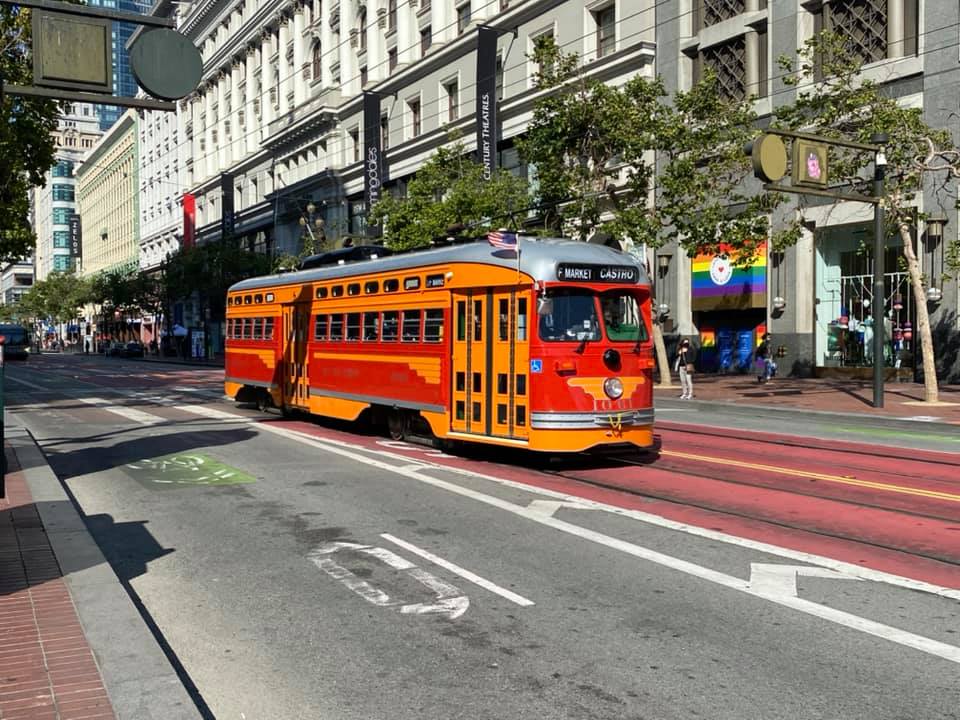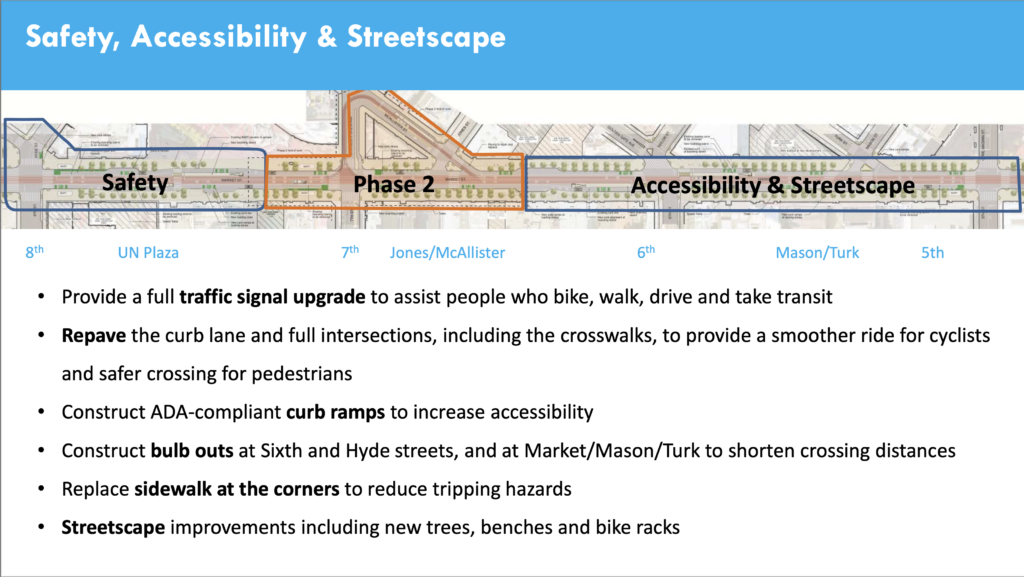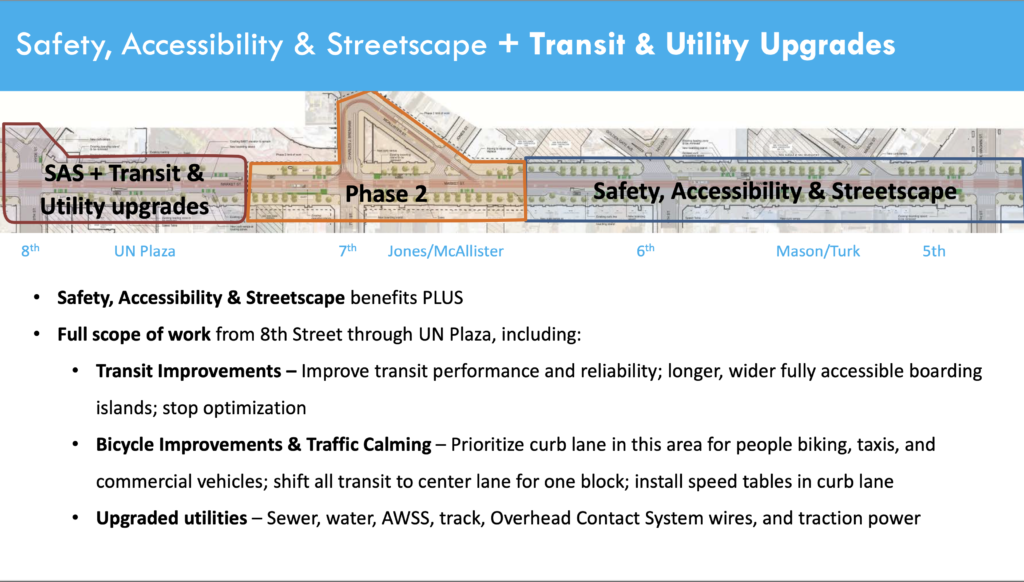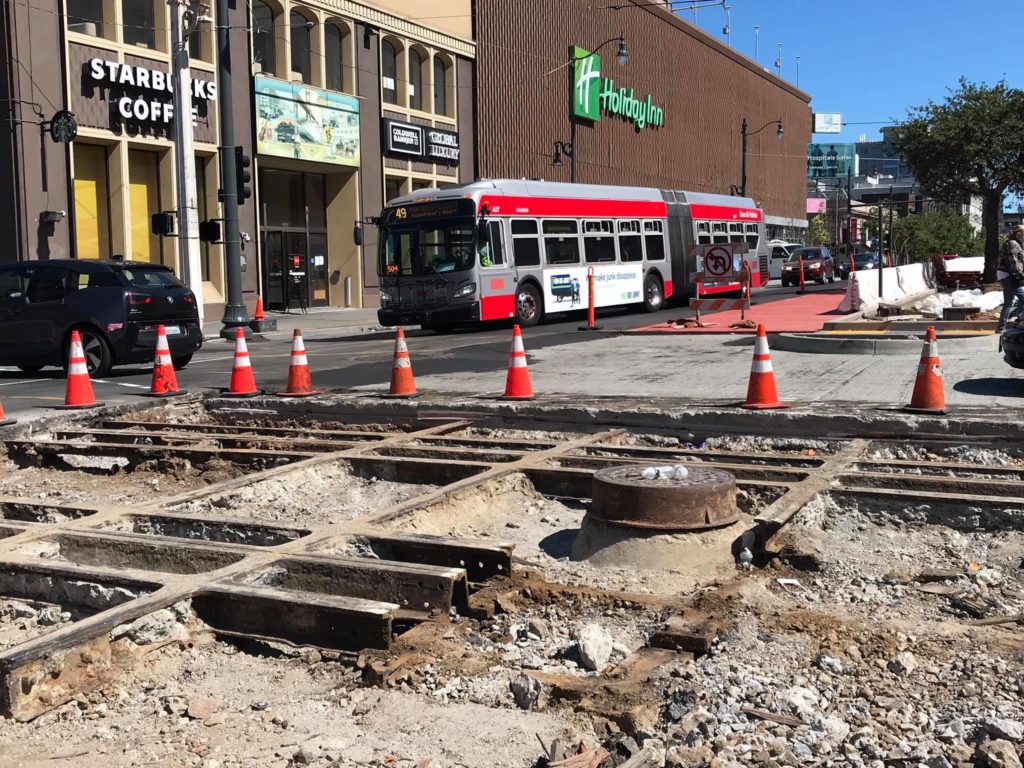More than ten years ago, the City proposed a modest project to repave downtown Market Street. Planners got involved; advocacy groups pushed to add more features; city departments weighed in with wish lists, all saying, “If you’re going to that that, you should also do THIS.” The project metastasized into a full rebuilding of everything on and under the street from curb to curb, from the foot of Market to Octavia Street, more than two miles.
Every inch of the project area has F-line tracks. And the time those tracks would be torn up kept getting longer, cutting off businesses along Market Street from the riders the popular streetcars bring to them. It was looking like just the first phase of work – three blocks of Market – could sideline the F-line streetcars for up to four years; the whole project could impede F-line service on Market 15 years or even longer, effectively killing the F-line on Market Street for a generation.

But now, after community pushback organized by Market Street Railway, the project has been reduced in scope for the second time, bringing it back closer to that initial repaving job (which is desperately needed now). A key to the change of heart on city leaders’ part was their recognition that now is not a good time to completely tear up our main street just as businesses affected by the project are struggling to recover from the pandemic.
On July 13, the project’s manager, Cristina Olea of the Department of Public Works (DPW), told the City’s Board of Supervisors (acting in their role as the governing body of the County Transportation Authority) that the already-reduced scope of the project’s first phase (between Fifth and Eighth Streets), with up to four years of no F-line west of Powell Street, was now off the table. She said the leaders of the three agencies involved, DPW, SFMTA (Muni), and the Public Utilities Commission, had listened to community concerns and asked for alternatives with less disruption to the F-line and to businesses along the route.
Two alternatives were put forward as information, with a decision still to come. Alternative one, called “Safety, Accessibility & Streetscape”, shown below, makes various improvements to the street surface but does not replace the F-line tracks, which Market Street Railway believes still have 20+ years of useful life remaining. F-line disruptions would be limited to short periods, usually weekends, for repaving intersections and running conduit for new traffic signals. The 500-foot stretch between McAllister and Seventh Street, where the much-needed F-line loop to provide extra service will be constructed) is shown on the drawings as Phase 2, but Olea stated that SFMTA engineers are now proceeding with detailed design for the loop, and it is possible that part or even all of it could be built at the tail end of Phase 1, which she estimated would now take two years instead of the previously estimated four years.

The second alternative, estimated to cost $60 million, would add transit and utility upgrades between Seventh and Eighth Streets, including underground utility replacement, F-line track replacement, and new, longer and wider Muni boarding islands, with Muni buses currently using the curb lane relocated to share the track lane with the F-line streetcars in that block. This option would in fact require a shutdown of F-line streetcar service west of Powell for two years. The chair of the Transportation Authority, Sup. Rafael Mandelman, expressed skepticism at Alternative 2, below, suggesting city agencies rethink the whole project scope beyond the basic improvements of Alternative 1 given the impacts of the pandemic.

In response, SFMTA boss Jeff Tumlin said Alternative 2 would provide city agencies with a test bed to see how new curb lane treatments to improve bicycle safety and discourage (now illegal) private motor vehicle use might work. Tumlin said it would also give the city agencies a better idea of just how complex the replacement of water and sewer lines would be.
In public comments at the meeting, Market Street Railway President Rick Laubscher expressed MSR’s preference for Alternative 1, involving the least disruption to the F-line. Regarding Alternative 2, he suggested that the block between Seventh and Eighth would not provide a true test of what it takes to replace the complex web of underground utilities beneath Market, because that block has a BART/Muni Metro station beneath the surface, meaning that all underground utilities in that block were replaced 50 years ago and are just half as old as those under the sections of Market Street where BART was tunneled rather than built from the surface down. Further, the location of the utilities above BART stations is well documented, unlike the parts of Market where BART construction didn’t affect existing utilities. If City leaders decide that a trial block of utility replacement is necessary, Laubscher suggested the block between Sixth and Seventh, with older underground utilities. The F-line loop switches and crossings on Market could be installed as part of the work on this block, eliminating the need for a separate shutdown to do that work later.
Hanging over the entire discussion: what many observers are calling “Van Mess” – a similar project to install bus rapid transit lanes and replace underground and above ground utilities along a two-mile stretch of Van Ness Avenue, which is about the same width as Market Street. The Van Ness project has gone way over schedule and budget. That project’s team has blamed the delay on finding unexpected utilities and other things underground, complicating utility replacement. The Van Ness project is still going on, and will end up taking twice as long as projected and costing tens of millions of dollars more. The ongoing delays caused several small businesses on Van Ness to go under, even before the pandemic.

But even though the utility problems under Van Ness were discovered at the beginning of that project, four years ago, the Market Street project team somehow waited until the last minute to translate those learnings into a greatly increased estimate of how long Market would take. And they still haven’t explained why it would take four years to do three blocks of Market when even with delays, they’re doing two miles of Van Ness – a project five times longer than those three blocks of Market – in not much more time than that.
We at Market Street Railway agree with those, including Supervisor Matt Haney, who represents mid-Market, that City agencies need to step back and consider a new vision for Market Street that recognizes the financial realities of the city and the impacts of travel and land use patterns altered by the effects of the pandemic. Even more important, we ask that city leaders study other cities with old utilities and surface streetcar tracks to identify faster and less disruptive ways to perform replacement projects. There are scores of cities in Europe alone that could provide good case studies, and Jeff Tumlin, as an experienced global transportation consultant with myriad connections in the industry, is the perfect leader to bring these lessons home to San Francisco.
The final decision on which alternative to pursue needs to be made in the next few weeks, according to project manager Cristina Olea, to keep some federal funding from expiring. The heads of SFMTA, DPW, and PUC will collectively make that decision, Olea told the Supervisors at the TA meeting, but SFCTA Chair Mandelman advised that they pay attention to community concerns about disruption. We at Market Street Railway believe that as our economy struggles to recover and attract visitor dollars back to San Francisco, it’s essential that the F-line keep running its whole route. We will keep you up to date on developments.
Best wishes to keep the F-Line running!